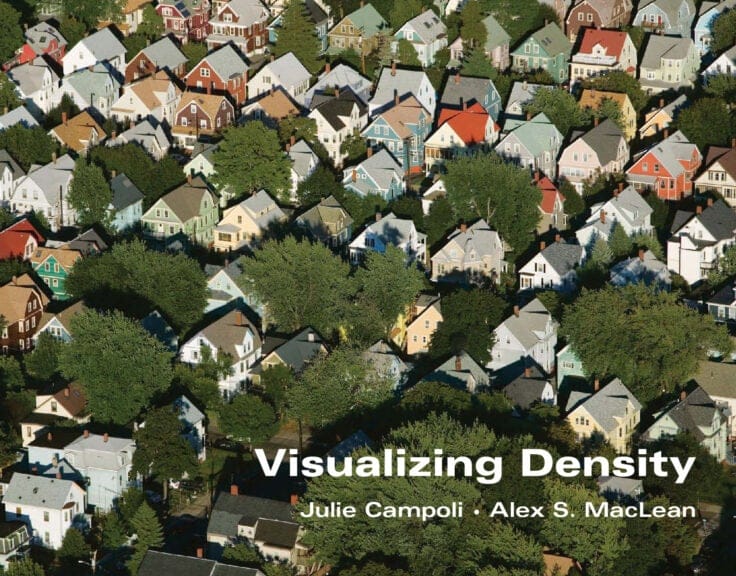Livros

Visualizing Density
Julie Campoli and Alex S. MacLean
Fevereiro 2007, inglês
Lincoln Institute of Land Policy
“There are plenty of reasons why dense development makes sense, but Americans are supposed to hate the ‘d-word,’ right? Campoli and MacLean show us how we can have it all – communities that are beautiful, affordable, efficient, and environmentally friendly. This book should be required reading for anyone who cares about the built environment.”
— Don Chen, Executive Director, Smart Growth America
This best-selling and richly illustrated book by landscape architect Julie Campoli and aerial photographer Alex S. MacLean helps planners, designers, public officials, and citizens better understand how residential density can help save energy, dollars, and the environment.
Julie Campoli is a landscape architect and urban designer and the principal of Terra Firma Urban Design in Burlington, Vermont. She has received grants from several foundations, including the National Endowment for the Arts and the Graham Foundation, for her studies of land settlement patterns.
Alex S. MacLean is the founder and principal of Landslides Aerial Photography based in Cambridge, Massachusetts. Trained as an architect at Harvard University Graduate School of Design, he has been a pilot and photographer for more than 25 years, documenting the history and evolution of the land and the changes brought by human intervention.
Reviews
“This vivid and visual book is one of the essential guides to understanding the concept of density. It provides aerial photos and street pattern maps for the entire range of housing density in America from 0.2 units per acre in Beverly Hills to nearly 300 units per acre in New York City. In this book version of the 2007 Planetizen Top Website 'Visualizing Density,' Campoli presents accurate descriptions of density and land use patterns in the United States, and offers the stepping stones to planning and designing for a society of greater density. MacLean’s beautiful and varied aerial photography gives an impressive view of hundreds of parts of the country and, at the same time, a disturbing look at the wasteful development pattern that has persevered in the U.S. for decades.”
— Named one of Planetizen's Top 10 Books of 2008
“This book makes an abstract concept—density—completely real and easy to understand, to feel. Planning board members, town zoning officials, or anyone charged with figuring out the vexing future of our physical landscape will profit from reading it, and find pleasure, too. It's like looking at Google Earth with someone very, very smart sitting next to you doing the play by play.”
—Bill McKibben, Visiting Scholar, Middlebury College; Author, Deep Economy: The Wealth of Communities and the Durable Future
“This beautiful book by Julie Campbell and Alex S. MacLean is an excellent reference for coming to grips with that slippery but important issue, density. Density can have both positive and negative connotations—and effects—depending on its context and execution. The photos in Visualizing Density illustrate this wonderfully, and can help us get a better mental grasp on the variety of ways people can live at a variety of different density levels.”
— Appeared in Post Carbon Cities
“We have two real choices for future development: We can grow more compactly or we can continue to sprawl across the landscape at great economic, environmental, and social cost. Julie Campoli and Alex MacLean show how to overcome opposition to density by focusing on good design. Through photographs and text they show how to neighborhoods of similar density can inspire either love or loathing depending on the quality of design in the buildings, landscape, and streets. If you want to understand opposition to density and how to overcome it, this book is invaluable.”
— Ed McMahon, Senior Resident Fellow, Urban Land Institute
Table of Contents
Foreword, Armando Carbonell
Growing Closer
The Count
The Coming Boom
Spreading Out or Growing In
Crosscurrents
The Benefits
Why We Hate Density
How We Can Love Density
Visualizing Density
Patterns of Density
Planning for Density
Designing for Density
The Density Catalog
Keywords
Desenvolvimento Comunitário, Meio Ambiente, SIG, Controles de Crescimento, Habitação, Infraestrutura, Monitoramento Fundiário, Uso do Solo, Planejamento de Uso do Solo, Espaço Aberto, Planejamento, Crescimento Inteligente, Desenho Urbano, Desenvolvimento Urbano, Espraiamento Urbano
